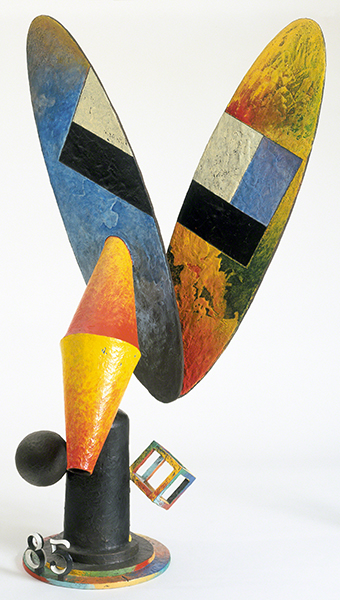Gem of the Month: Robert Hudson
Robert Hudson’s birthday was on the 8th of September, and seeing this piece again made me elect him to my vaunted Gem of the Month club. His art is part of the West Coast assemblage phenomenon that blossomed in the 1960s in San Francisco. This type of art is sometimes labeled Funk (or Junk) Art.
 |
| Robert Hudson (born 1938, U.S.), Jack Rabbit, 1985. Unique polychrome bronze, 45" x 17" x 11 ¼" (114.3 x 43.2 x 28.6 cm). Buffalo AKG Art Museum, Buffalo, New York, gift of Seymour H. Knox, Jr. © 2023 Robert Hudson. (AK-1536) |
Hudson's work juxtaposes manufactured and found objects. His subject matter and titles reflect the wit of the Funk Art movement, which often verged on the risqué. There is a tension between the illusionistic nature of the painting in Jack Rabbit and its three-dimensional form that mimics a rabbit's ears. That said, Hudson's works are complex visual manipulations, even though, like many Funk works, his pieces may look quickly or randomly assembled. His art consistently defies the barriers between art forms. In many of his works, like Jack Rabbit, the painting gives the flat pieces of the sculpture a trompe-l'oeil sense of three dimensionality. This piece is a bronze cast taken from objects found by the artist.
Until the late 1950s, radical experiments in modernism in American art came mostly from the East Coast art scene. This was particularly true with the advent of Abstract Expressionism in the late 1940s. Abstract Expressionism was a powerful force in American art, and the New York art world cherished its self-perceived role of modernist art leadership.
One of the first rebellions against the domination of the New York School came from San Francisco, where several uncoordinated and totally different movements began to gel in the late 1950s. The one thing that all of these trends had in common was the rejection of total abstraction and process-orientation in favor of the tangible.
The term Funk Art came from the 1967 Berkeley Art Museum exhibit Funk, which summed up the many trends in sculpture and ceramic art that had developed in reaction to the New York School. “Funk” came from the late 1950s/early 1960s Beat movement in which “funky” was jazz term of approval. Jazz was perceived at the time as unrefined, and this fit Funk Art perfectly in that many of the artists’ work was rough around the edges and unorthodox. The movement evolved around the University of California, Davis, art department where many of the artists were either students or faculty. Funk's heyday was the mid to late 1960s.
Hudson grew up in Richland, Washington, after being born in Salt Lake City, Utah. He moved to San Francisco in the late 1950s to study art. He received a BA there in 1961 and an MFA in 1963. In San Francisco, he was influenced by the ceramic artist scene, whose artists used bright colors, combining ceramic “craft” with sculpture. Likewise, Hudson's sculptures blur the lines between painting, drawing, and sculpture. Hudson has been a primary figure in the West Coast assemblage movement and is particularly renowned for his polychrome steel sculpture. He has also worked in a variety of other media including painting, drawing, and ceramics. His bold challenges to barriers between juxtaposed art forms represent the true meaning of “hybridity” in art.
Correlations to Davis programs: Explorations in Art 2E Grade 4: 6.2; Experience Art: 4.2; A Global Pursuit 2E: 8.3; The Visual Experience 4E: 10.7, pp. 70–71; Beginning Sculpture: Chapters 4 and 6


Comments